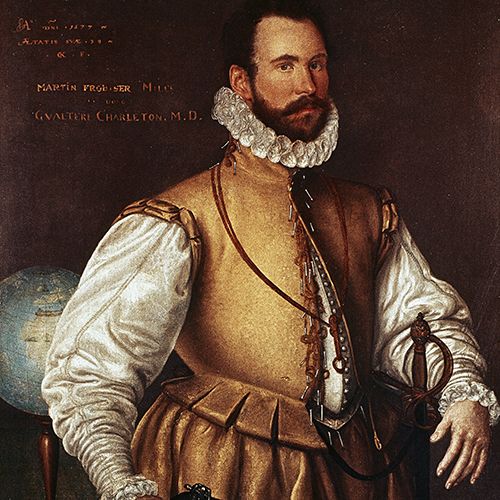You are viewing the article Martin Frobisher at Tnhelearning.edu.vn you can quickly access the necessary information in the table of contents of the article below.

(1535-1594)
Who Was Martin Frobisher?
Martin Frobisher was an English explorer who became a licensed pirate and plundered French ships off the coast of Africa. In the 1570s, he made three voyages to discover a Northwest Passage. Instead, he discovered Labrador and what is now Frobisher Bay. Later, he was knighted for fighting against the Spanish Armada.
Early Life
Martin Frobisher was born in 1535 (some say 1539) in Yorkshire, England. His merchant father, Bernard Frobisher, sent him to stay with a relative, Sir John York, in London, where Frobisher attended school. In his early years, Frobisher came into contact with London seamen and developed an interest in navigation and exploration. His goal, like that of many explorers of the time, was to discover the fabled Northwest Passage—a sea route above North America that linked the Pacific and Atlantic oceans.
Frobisher’s travels began in the 1550s, when he explored Africa’s northwest coast, particularly Guinea, in 1553 and 1554. The following year, Frobisher became an Elizabethan privateer, or lawful pirate, who was authorized by the English crown to plunder enemy nations’ treasure ships. In the 1560s, Frobisher gained a reputation for preying on French trading vessels in the waters off Guinea; he was arrested several times on piracy charges, but never tried.
New World Voyages
It was for his three voyages to what was then called the New World that Frobisher became a famed explorer. He was among the first English explorers to sail the northeast coast of North America.
Determined to find a Northwest Passage, Frobisher worked for five years to obtain funding for his expedition. He convinced the Muscovy Company, an English merchant consortium, and its director, Michael Lok, to license him and then raised enough money for three ships. He set sail on June 7, 1576, and sighted the coast of what is now Labrador, Canada, on July 28. Several days later, he sailed through the bay that now bears his name, Frobisher Bay. Because of windy and icy conditions, Frobisher could not continue to sail north, so he sailed west instead and reached Baffin Island on August 18.
On Baffin Island, a group of natives captured several members of Frobisher’s crew, and despite several attempts to get them back, Frobisher was unable to retrieve them. He set sail back to England and took with him a piece of black stone that he believed to contain gold. Frobisher’s reports of possible gold mines convinced investors to fund a second voyage.
On May 27, 1577, Frobisher set out to sea again, this time with additional funding, ships and men. He reached Frobisher Bay on July 17 and spent several weeks collecting ore. He was directed by his commission to defer discovery of the passage to another time and focus on gathering precious metals. Frobisher and his crew brought 200 tons of what they believed to be gold ore back to England.
England’s queen, Elizabeth I, had strong faith in the fertility of the new territory. She sent Frobisher back for a third voyage, this time on a much larger expedition, with 15 vessels and the necessities for establishing a 100-man colony. Frobisher set sail on June 3, 1578, and landed at Frobisher Bay in early July. He and his men failed to establish a settlement as a result of dissension and discontent, and they all returned to England with 1,350 tons of ore. Upon their return, it was discovered that the ore was actually iron pyrite and therefore worthless, although it was eventually used for road metalling. Since the ores proved valueless, Frobisher’s financing collapsed and he was forced to seek other employment.
Battles and Death
In 1585, Frobisher returned to the seas as the vice admiral of Sir Francis Drake’s expedition to the West Indies. Three years later, he fought for the English against the Spanish Armada and was knighted for his efforts. In the six years that followed, Frobisher headed several English squadrons, including one that attempted to intercept Spanish treasure ships in the Azores. During a scuffle with Spanish forces in November 1594 during the Siege of Fort Crozon, Frobisher was shot. He died several days later, on November 15, in Plymouth, England.
QUICK FACTS
- Birth Year: 1535
- Birth City: Yorkshire, England
- Birth Country: United Kingdom
- Gender: Male
- Best Known For: English explorer Martin Frobisher is best known for his attempts to discover a Northwest Passage and his voyages to Labrador and Frobisher Bay in Canada.
- Death Year: 1594
- Death date: November 15, 1594
- Death City: Plymouth, England
- Death Country: United Kingdom
Fact Check
We strive for accuracy and fairness.If you see something that doesn’t look right,contact us!
CITATION INFORMATION
- Article Title: Martin Frobisher Biography
- Author: Biography.com Editors
- Website Name: The Biography.com website
- Url: https://www.biography.com/history-culture/martin-frobisher
- Access Date:
- Publisher: A&E; Television Networks
- Last Updated: March 26, 2021
- Original Published Date: April 2, 2014
Thank you for reading this post Martin Frobisher at Tnhelearning.edu.vn You can comment, see more related articles below and hope to help you with interesting information.
Related Search:



